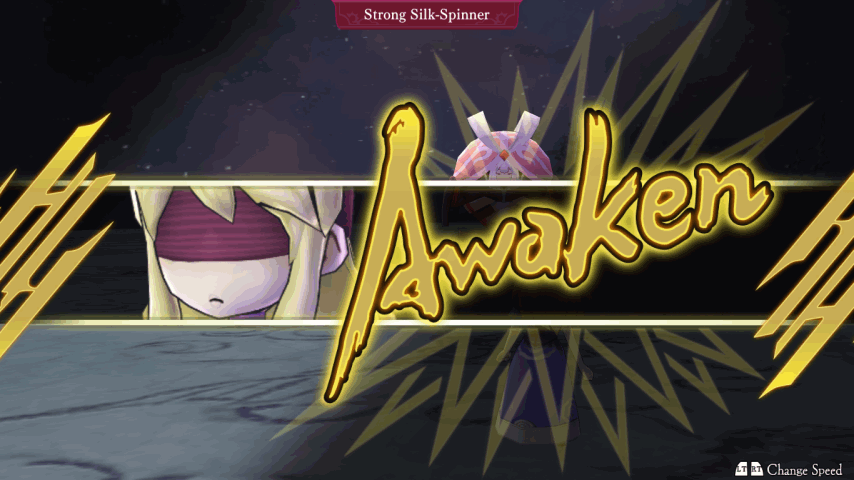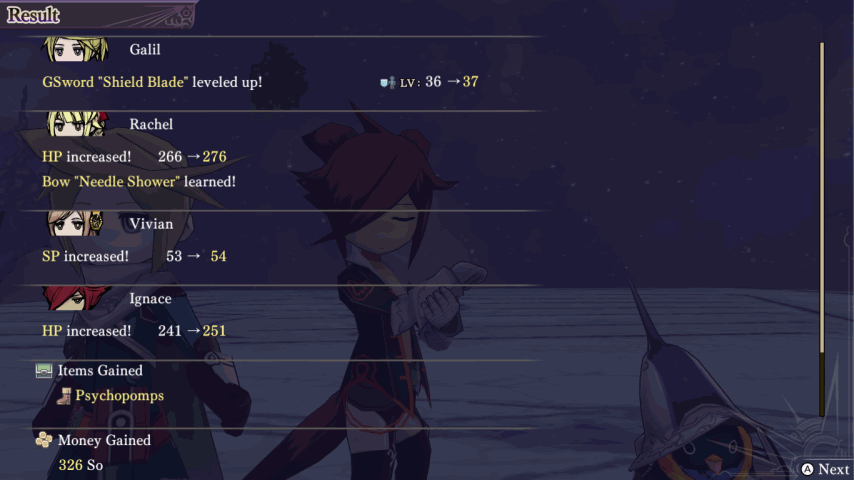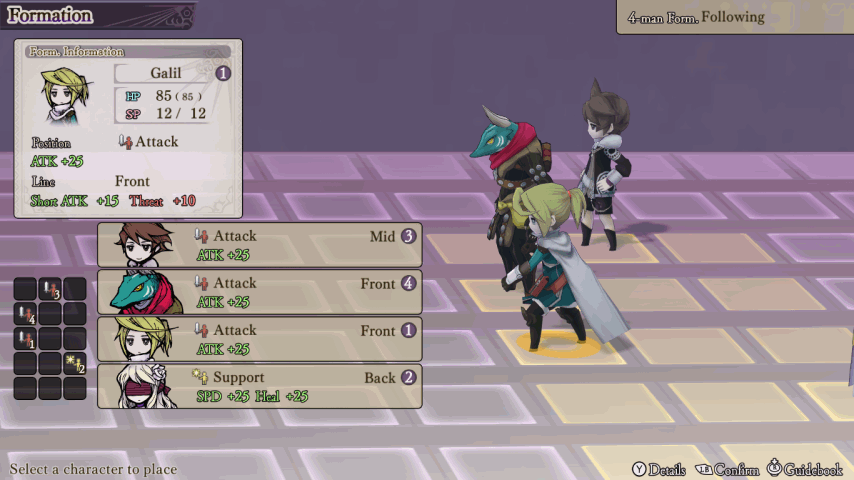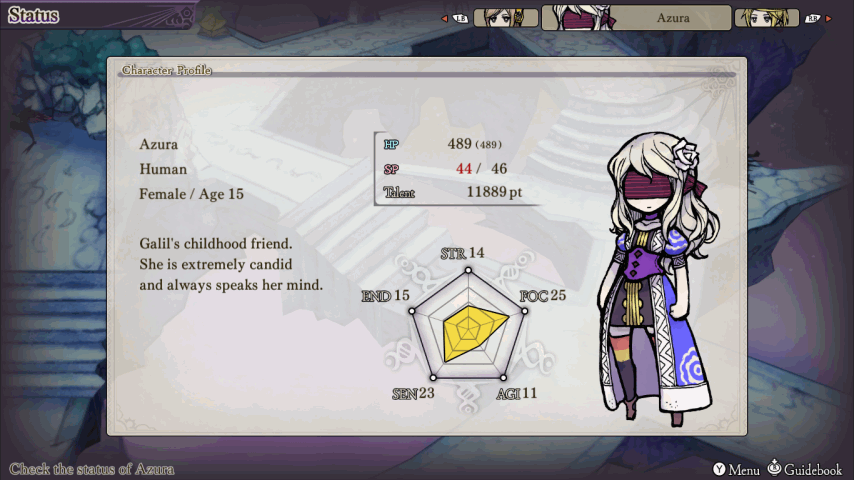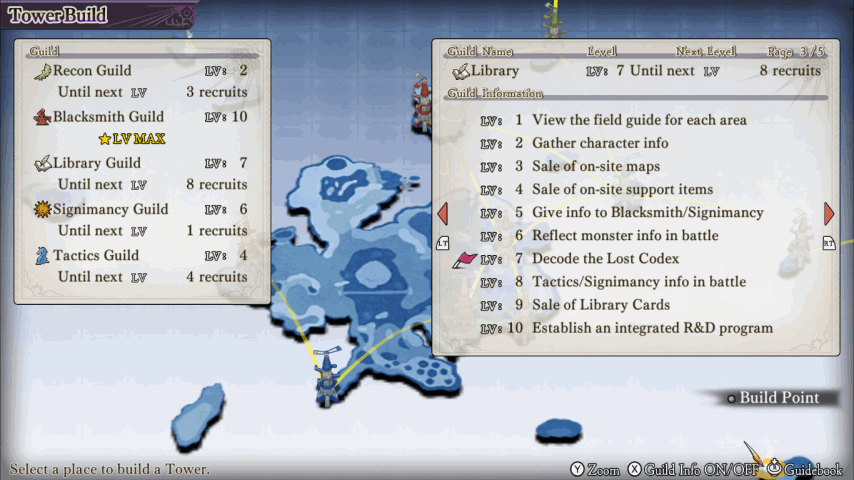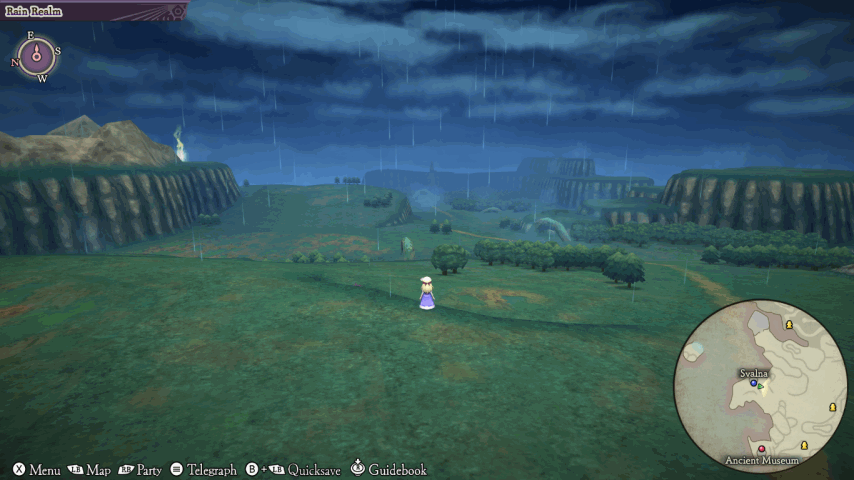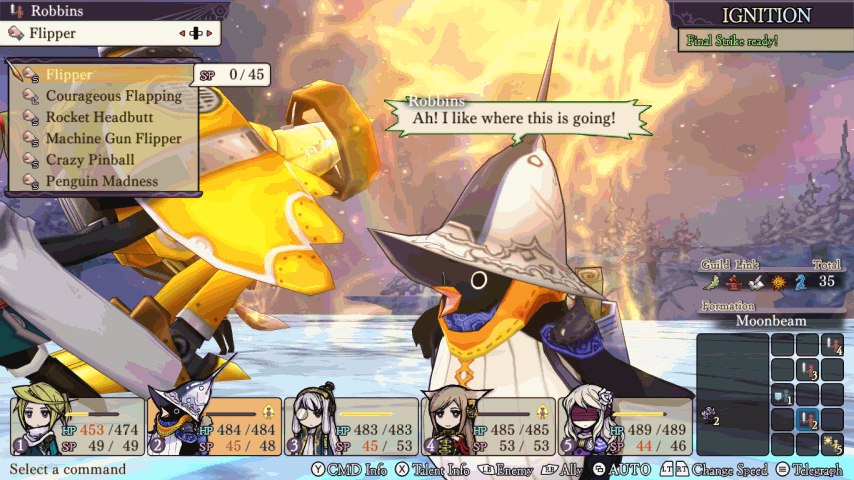2023-08-06: The Alliance Alive -- SaGa Made More Accessible
SaGa games come with a reputation for being difficult, obtuse, and designed to punish the player for engaging in behaviors that are considered typical for other JRPGs. They punish grinding, reward sticking to one plan, but also require exploration to find the best plans and builds to use due to a combination of opaque complicated mechanics and convoluted trees of skill unlocks. Getting into them is a bit of a challenge (and one I have yet to actually fully tackle myself).
Getting started in SaGa presents a newbie with a couple options for easier experiences: SaGa 3 (preferably the DS remake), SaGa Frontier (where restarting a chapter is far less punishing if you screw up and the remake adds help systems), or Scarlet Grace (which is newer and comes with some QoL and learning options). These are all undoubtedly very "SaGa" and throw you into the deep end with their systems. This week I discovered a new option that serves as a far more mild (and charming) introduction to the SaGa systems: The Alliance Alive.
To call TAA just a softer SaGa doesn't really do it justice. TAA is a completely unique concept with an incredibly endearing aesthetic, plot, ambiance, and feel to it that just happens to weave SaGa concepts into an easier, softer package incredibly well. Originally a 3DS release, TAA has seen an HD remaster release on practically everything; with varying quality depending on platform. I played through the Steam version, which I don't necessarily recommend but I'll get into that.
A Lot of Words on TAA and SaGa Mechanics
Once your duo of Galil (a rather flat, calm, very unwilling would-be hero) and Azura (an extremely energetic borderline domineering magician) are out in the field, the mechanics come in pretty quick. Your first battle presents you with the SaGa trappings: the ability to swap between weapon slots, skill rosters per weapon type, HP that recovers itself after battle, very limited magic points (SP), a complete lack of experience points in favor of gaining stats in small chunks each fight, and sparks. You'll probably spark something or other in your first fight, just so you get to see how it looks.
Sparking is the main unit of currency in SaGa progression. In short it boils down to "You use an ability, but your character randomly decides to use a different ability and you learn it forever". This can result in frustrating situations where your sparked ability is not what you wanted, but it's rare and, typically, sparking grants you a far more powerful move. Each weapon type in TAA has a pool of about 20 moves costing anywhere from 0 to 15 SP, where you can expect to have a max of 60 SP by endgame. Big splashy moves are expensive but oh so good. Sparking them is a treat. Sparking however also depends on the difficulty of the foes and, in TAA at least, there seems to be a limit on how far you can go based on what you're fighting.
In practically every battle you can expect to gain a couple of HP or an SP on someone in your party. Over time these rewards build up into a smooth progression of character power. Your base stats however like Strength and Endurance are static and only changed by equipment. Between getting more SP so you can use bigger moves and sparking new skills, you have the complete SaGa growth experience, but TAA adds a couple more mechanics to give the player more tools if they find this constraining.
Every skill in TAA has three power levels, associated with what role the character is playing in the party. Whether your character is in Attack, Guard, or Support posture determines which level is referenced for the skill's total power. Using a skill in a given posture has a chance to increase that skill's posture level so if you go the entire game casting one spell from the Attack posture, it'll level up and become more powerful when used that way. This represents a significant portion of how powerful a skill is to the point that using one skill for the entire intro of the game might render it more powerful than even end-game skills unless you go grind. This isn't a bad thing really. Being able to tear enemies in half with a free skill because you spammed it all game is pretty neat.
Attack, Guard, and Support postures are determined by formations. Formations are customized layouts of your party on a 3x5 grid where placing a party member in a given row gives them specific buffs and debuffs, then giving them a specific posture gives them yet more tweaks and sets what posture levels their skills use and train. Other SaGa games have formations but for the most part they're not this clear, well-explained, or customized. Romancing SaGa 3's formations, as a comparison, are absolutely obtuse.
This entire system gives you a sort of back door into the SaGa world where, if you're having trouble getting rolling, you can resort to just slapping your party into hard-set postures and training your skills to level them to the point that you'll get powerful enough to progress. This translates to "grind" if you're having trouble, which is fine in TAA because TAA also completely disposes of the concept of Battle Rank. BR in SaGa games is an ever-present threat where enemies get more difficult the more battles you fight. This is typically how these games punish grind; TAA doesn't.
You eventually get access to nine party members (or twelve if you find three optionals), and can field five at any time. The remaining members sit on the bench and don't gain anything, but the game only mandates specific character choices a couple of times, and the times it does all fall within the same hour or so of gameplay to force you to eventually field everyone; then never again. If you truly only want to field five specific characters the whole game, you can and not really be punished for it. They will get very strong.
Every character comes with a stat bias toward a specific combat style but you can ignore it and stick any party member with any weapon. Want to give the white mage aspected lady a greatsword? Sure go for it. It won't ever be as good as giving it to someone with high Strength but it'll work in time. Everyone will eventually get the same skills via sparks (with the exception of two "special" party members who have limitations).
Given all this, you're pretty free to experiment and change up your build any time you want and you'll spark, gain, and level back up to where you were pretty quickly. This is a freedom you don't really have in other SaGa games because of Battle Rank. However I found as long as you pick a strategy and stick to it, you will very quickly and consistently outgrow the difficulty curve of the game. Any strategy really should work.
Once you forge the titular Alliance, you can start allocating staff and resources to one of five artisan guilds. This forms the meat of the mid-game where you are given the ability to travel the world and can find, recruit, and rescue NPCs into your alliance and assign them to work under a specific guild. Each guild levels up based on how many members it has and produces new rewards for you: the Blacksmith Guild can make you gear that outstrips what you can get normally, the Signimancy Guild can give you powerful new spells, the Library Guild can give you assorted benefits in combat based on your world exploration and such, the Recon Guild gives you free rest spots in dungeons and increases various battle rewards, and the Tactics Guild gives you new formation options.
These are essentially just free value. Because you're free to build your Alliance any way you see fit, the game is not balanced around the presence or absence of these bonuses. Going all in on leveling up a guild will give you tools the game does not require or expect; yet another way to just overpower the game if you want it.
But that's not all. In order to get some sense of battles directly translating to numeric power, TAA adds talents. Talents are buffs on each character that are unlocked by gaining talent points. These work just like experience, so there's a system where you're gaining something each fight, even if you don't spark or gain HP. These are mostly quality of life things like SP cost reductions on skills, but balloon out into some pretty big game changers like the threat control talents that change how often enemies attack various slots in your party. It's all, like the guilds, just extra value.
This is all a long-winded way of saying you can't really "build wrong" in TAA. At worst something you try isn't working and you can just grind it until it becomes effective, or change it up and spark skills rapid-fire to catch up. It does translate to an easy experience, but that's okay too. You'll come away feeling like you get the basics of how SaGa works without getting your teeth kicked in by a water dragon because you walked into the wrong cave and are now stuck.
Plot and Aesthetics
Alliance Alive came on the heels of Bravely Default taking off. Initially releasing on the 3DS very late in its lifecycle, TAA takes a lot of cues from that series. The art style, interface, general battle look and feel, and even some of the major mechanical gimmicks (like zooming out in town if you don't move for a moment) all scream "Bravely Default at home". In a way this should serve to give a player a comfortable starting point before diving off into SaGa mechanic land: the comparisons to Bravely are surface level at most.
The plot scaffolding at the start is pretty simple: your party is trapped in a world of infinite rain, under the boot of a force of demonic humanoids who took over the entire planet and divided humanity into zones to prevent trade and cultural exchange with a strange wall of dark energy. Controlling two kids who are newbies in the resistance, you go on basic missions that start unspooling into a major intrigue regarding a ship that is rumored to be able to cross the barrier. Getting such a ship would allow the reunification of humanity (into an alliance, you might say) and form the basis for fighting back against the daemons.
It's refreshingly direct. You're out in the field and playing with the game's mechanics in 5 minutes. 10 if you talk to everyone in town first.
Aesthetically the game uses a heavily outlined 3D style and flat lighting that makes it look almost like papercraft. It's somewhat reminiscent of Okami in that way, though ink pens more than brushwork. Character expressions are exaggerated and there's a lot of visual punctuation on emotions, reactions, and expressions. A lot of sweat drop word balloons and happy lines and such. It gives a cartoony vibe to the fairly grim resistance story that lies underneath. Characters are fairly one-dimensional in how they act but have deeper motivations and thoughts in dialogue, giving a sort of "talk deep, act shallow" vibe to the plot.
There is no voicework in the game. Everything is done in text including cutscenes where they attempted to weave textual communication in with movies with full motion and choreography, so sometimes the text progresses too slow or too fast for one's liking. Some people say the lack of voice acting dings the immersion of the game; I think it leaves more room for characterization in the player's own mind. It's a matter of taste, to be sure.
The game also absolutely does not take itself seriously, happily throwing wild things into the mix like a 12 year old mechanical genius who pilots a rubber duck mech into battle, comedic awkward tension around the two core protagonists having a crush on each other, absolute off the wall dialogue during pivotal plot points, and a penguin. Yeah the penguin. He's great and recruiting him is essentially the same as ticking the "Wild Wasteland" trait in a Fallout game. He's miss-able, which is a crime.
The plot itself doesn't move much through the game. You start as a nobody resistance member against the daemons, are quickly rushed from that role to that of the captain of the only ship capable of crossing the dark barrier dividing the world, and then to the leader of the unified front of humanity in their fight back against the daemons. Only in the final leg of the game are any major motivations or identities of the antagonists fully revealed. Most of the game is about recruiting NPCs and beefing up your guilds. This fits the cadence of the game excellently though. You're left to your own devices a couple of times through the game and it just feels like the perfect time to go exploring and finding recruits.
If you're the kind of person who just wants to hop from plot point to plot point, you won't like this vibe; but this is the vibe of SaGa in general. 75% of the game is in places you have no reason to ever go.
It would be a crime though to mention the aesthetics and not talk about the music. Alliance Alive's music is amazing and may be its strongest point. Each town has its own theme that just speaks intently to what that town is all about. The music that plays any time you enter a guild hall you control is upbeat and hopeful, with a thrumming synth that carries a feeling of "work is being done here". Regions pounded by rain carefully understate their soundtrack to the point of not having battle music on easier fights, leaving a feeling of calm ennui between the white noise of the raindrops. It's all perfect.
150 Words on the HD Remaster
The HD remaster of TAA frees the game from the 3DS. It adds high render resolution, anti-aliasing, a story reminder system if you put the game down for awhile, some better tutorialization, and that's about it. The definitive edition to play is the Switch edition.
The PC/Steam edition of TAA has some major technical issues: I crashed about two dozen times through the game and twice had a location in the game just load into a black screen, rendering it completely inaccessible. I was lucky neither location was plot-relevant. Anecdotal experience from both myself and others is that most of these problems occur in the first 10 hours then get better. I still had the random crash though and if you don't save religiously like I do this is a recipe for pain.
Switch version is great though, I know a bunch of people who played it with no problems.
Summary
TAA is one of those games you "Just play". If you establish a strategy and stick to it, and use the tools you have available like formations and guilds, you'll overpower the difficulty curve early on and it'll never really catch back up. Some reviews complain the game is too hard because you have to change weapon styles to keep equipping weapon upgrades; this is the wrong way to approach a SaGa style game. Your power comes from your sparks far, far more than the numbers on your weapons.
The plot's a trip and the way it unfolds is a delight. You might be splattering enemies into a fine red mist if you don't skip battles and have a coherent party build, but that never really wore out its welcome with me. You're given a couple of very well lampshaded opportunities to explore the world and that'll easily add hours to the playtime if you want to get everything you can.
You can't get everything though; several recruits are gated behind New Game+ and even then you can't max your guilds out entirely. Guild building is a game of choices. My only recommendation here is to start Blacksmith, get that really good gear, then ignore it in New Game+ because you're already well equipped.
When you finish TAA you'll have an idea of how SaGa games work at the core. From there a newbie might have a better shot at something with Battle Rank and not as many friendly mechanics to assist in catching up if they fall behind. Me? I'm trying The Last Remnant next, which is possibly the polar opposite of TAA on the "Take SaGa and make it more polite" scale.
tags: game_writeup, rpg, alliance_alive
